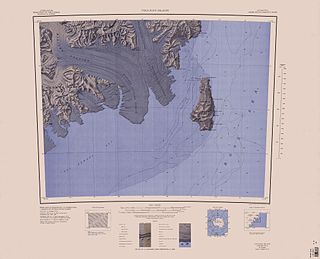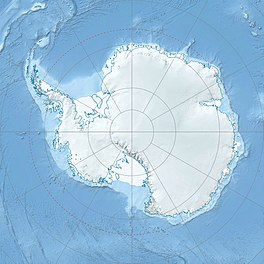
Lillie Glacier is a large glacier in Antarctica, about 100 nautical miles (190 km) long and 10 nautical miles (19 km) wide. It lies between the Bowers Mountains on the west and the Concord Mountains and Anare Mountains on the east, flowing to Ob' Bay on the coast and forming the Lillie Glacier Tongue.

Borchgrevink Glacier is a large glacier in the Victory Mountains, Victoria Land, draining south between Malta Plateau and Daniell Peninsula, and thence projecting into Glacier Strait, Ross Sea, as a floating glacier tongue, the Borchgrevink Glacier Tongue, just south of Cape Jones. It was named by the New Zealand Geological Survey Antarctic Expedition, 1957–58, for Carsten Borchgrevink, leader of the British Antarctic Expedition, 1898–1900. Borchgrevink visited the area in February 1900 and first observed the seaward portion of the glacier.
Collins Glacier is a glacier about 11 nautical miles (20 km) wide at its confluence with the Mellor Glacier, which it feeds from the southwest, located north of Mount Newton in the Prince Charles Mountains of Antarctica. It was mapped by the Australian National Antarctic Research Expeditions from air photos taken in 1956 and 1960, and named by the Antarctic Names Committee of Australia for Neville Joseph Collins, senior diesel mechanic at Mawson Station, 1960.
The LeMay Range is a mountain range 40 nautical miles (70 km) long with peaks rising to 2,000 metres (6,600 ft), extending in a northwest–southeast direction from Snick Pass to the north side of Uranus Glacier in the central portion of Alexander Island, Antarctica. It was first seen from the air by Lincoln Ellsworth on November 23, 1935, and the north and east portions mapped from photos obtained on that flight by W.L.G. Joerg. Later, it was resighted from the air by the Ronne Antarctic Research Expedition (RARE), 1947–48, and named by Finn Ronne for General Curtis LeMay, Deputy Chief of Air Staff for Research and Development of the then United States Army Air Forces, which furnished equipment for the expedition. The range was remapped in detail from RARE photos by D. Searle of the Falkland Islands Dependencies Survey in 1960.
Uranus Glacier is a glacier on the east coast of Alexander Island, Antarctica, 30 kilometres long and 10 km (6 mi) wide at its mouth, flowing east into George VI Sound immediately south of Fossil Bluff. Along the south face of the glacier is an east–west escarpment called Kuiper Scarp.
Sibelius Glacier is a glacier, 12 miles (19 km) long and 6 miles (10 km) wide, flowing south into the Mozart Ice Piedmont 10 miles (16 km) southwest of Mount Stephenson situated in the northern portion of Alexander Island, Antarctica. The glacier was first sighted from the air by the British Graham Land Expedition in 1937. Mapped from air photos taken by the Ronne Antarctic Research Expedition in 1947–48, by Searle of the Falkland Islands Dependencies Survey in 1960. This feature was named by the United Kingdom Antarctic Place-Names Committee for Jean Sibelius (1865-1957), Finnish composer.

Haas Glacier is a steep tributary glacier draining northward from Rawson Plateau to enter the south side of Bowman Glacier, in the Queen Maud Mountains of Antarctica. It was mapped by the United States Geological Survey from surveys and U.S. Navy air photos, 1960–64, and was named by the Advisory Committee on Antarctic Names for Charles G. Haas, a meteorologist in the South Pole Station winter party, 1960.
Breplogen Mountain is a broad mountain, 2,725 metres (8,940 ft) high, which is ice-covered except on its north and east sides, standing west of Austreskorve Glacier in the Mühlig-Hofmann Mountains of Queen Maud Land.
Styggebrekkufsa Bluff is a bluff overlooking the cast-central part of Austreskorve Glacier in the Muhlig-Hofmann Mountains of Queen Maud Land. Plotted from surveys and air photos by the Norwegian Antarctic Expedition (1956–60) and named Styggebrekkufsa.

Vinje Glacier is a broad glacier about 20 nautical miles (37 km) long flowing northwest between the Filchner Mountains and Fenriskjeften Mountain in Queen Maud Land. Mapped by Norwegian cartographers from surveys and air photos by the Norwegian Antarctic Expedition (1956–60) and named for T. Vinje, meteorologist with Norwegian Antarctic Expedition (1956–58).
Eros Glacier is a glacier on the east coast of Alexander Island, Antarctica, 7 nautical miles (13 km) long and 2 nautical miles (4 km) wide at its mouth, flowing southeast from the Planet Heights into George VI Sound immediately north of Fossil Bluff. It was probably first seen on November 23, 1935, by Lincoln Ellsworth, who flew directly over the glacier and obtained photos of features north and south of it. The mouth of the glacier was observed and positioned by the British Graham Land Expedition in 1936 and the Falkland Islands Dependencies Survey (FIDS) in 1948 and 1949. The glacier was mapped in detail from air photos taken by the Ronne Antarctic Research Expedition, 1947–48, by D. Searle of the FIDS in 1960. It was named by the UK Antarctic Place-Names Committee after the minor planet Eros in association with nearby Pluto Glacier and Uranus Glacier.

Gjel Glacier is a glacier, 17 nautical miles (31 km) long, flowing north between the steep cliffs of the Luncke Range and Mefjell Mountain, in the Sør Rondane Mountains of Antarctica. It was mapped by Norwegian cartographers in 1957 from air photos taken by U.S. Navy Operation Highjump, 1946–47, and named Gjelbreen.
Moubray Piedmont Glacier is a piedmont glacier filling the northern part of Moubray Bay, Antarctica, formed by the confluence of Moubray Glacier and of ice streams falling from the west side of the south end of Adare Peninsula. The greater part of it is probably afloat. It was named by the New Zealand Geological Survey Antarctic Expedition of 1957–58 for Moubray Bay.
The Milky Way is a col situated between the southernmost extremity of the LeMay Range and the Planet Heights mountain range, in the eastern part of Alexander Island, Antarctica. It is the highest point on a possible sledging route between Jupiter Glacier and Uranus Glacier. The col was first mapped from air photos taken by the Ronne Antarctic Research Expedition in 1947–48, by D. Searle of the Falkland Islands Dependencies Survey in 1960. It was named after the Milky Way by the UK Antarctic Place-Names Committee from association with the nearby Planet Heights and the glaciers which are named for the planets of the Solar System.

Mendeleyev Glacier is a glacier, 10 nautical miles (19 km) long, draining northeast through the northern outcrops of the Payer Mountains, in Queen Maud Land, Antarctica. It was mapped from air photos and surveys by the Soviet Antarctic Expedition, 1960–61, and named after Russian chemist Dmitri Mendeleev, whose surname may also be transliterated as "Mendeleyev".
Tvireita Moraine is a moraine, about 5 nautical miles (9 km) long, comprising two somewhat parallel segments that appear to unite as they trend northeast, located in the east part of Mendeleyev Glacier in the Payer Mountains, Queen Maud Land. Plotted from air photos and surveys by Norwegian Antarctic Expedition, 1956–60, and named Tvireita.
Stenka Mountain is a mountain, 2,350 m, forming the central part of Spraglegga Ridge in the Payer Mountains of Queen Maud Land. Discovered and plotted from air photos by the German Antarctic Expedition, 1938/39. Mapped from air photos and surveys by Norwegian Antarctic Expedition, 1956–60; remapped by Soviet Antarctic Expedition, 1960/61, and named Gora Stenka.
Spraglegga Ridge is a ridge that is partly rock and partly covered by snow, surmounted by Stenka Mountain, standing 4.5 nautical miles (8 km) southeast of Kvaevefjellet Mountain in the Payer Mountains, Queen Maud Land. Discovered and plotted from air photos by German Antarctic Expedition, 1938–39. Replotted from air photos and surveys by Norwegian Antarctic Expedition, 1956 60, and named Spraglegga.
Horteflaket Névé is a névé at the head of Mushketov Glacier, between the Petermann Ranges and the Weyprecht Mountains in Queen Maud Land, Antarctica. First plotted from air photos by the Third German Antarctic Expedition, 1938–39, it was replotted from air photos and surveys by the Sixth Norwegian Antarctic Expedition, 1956–60, and named by them.





